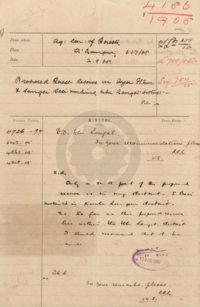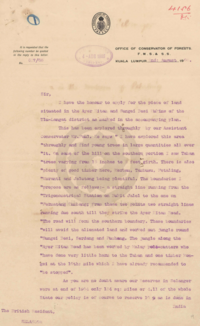Jadual Kandungan
Gutta Percha di Malaya
Dirujuk oleh
Perihal
“Gutta perca” atau “nyatoh taban merah” ialah sejenis getah berketahanan tinggi yang banyak digunakan sebagai kabel dasar laut dan peralatan-peralatan lain. Permintaannya tinggi di musim-musim peperangan, oleh kerana ianya turut menjadi bahan buatan alat-alat persenjataan serta jaringan komunikasi.
“The name ‘gutta’ means ‘getah’ in Malay language means latex/ gum; while ‘percha’ is the local name of the tree. The gutta percha or nyatoh taban merah (Palaquium gutta) from the Sapotaceae family is a medium-size timber tree which can reach the height of 35 m. This species is found in lowland forests in Peninsular Malaysia, Singapore, Sumatra and Borneo. Gutta percha is a lightweight hardwood suitable for the making of interior decorative items and panel. Its leaves are yellowish-green or rusty green with copper-coloured veins and the flowers are small. The tree begins producing white rubber after 15 years’ old. At room temperature, gutta percha latex is hard but when heated, it can be moulded into various shapes. Gutta percha was first introduced in Europe and marketed after it was known to have the appropriate properties (flexible, able to withstand high pressure and cold temperature) for coating submarine electric cables. In addition, the latex is also used as a golf ball coating, in dental treatment as well as for the making of pistol grip and jewelry.”
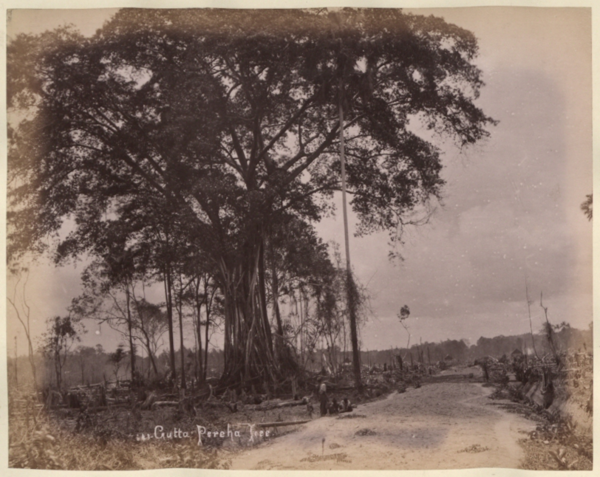
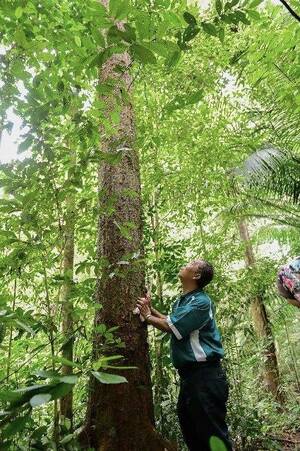
Kiri: Contoh pokok gutta percha zaman dahulu (1900-an). (The National Archives UK, 1860-1900: |"CO 1069-484-020").
Kanan: Contoh pokok gutta percha kini: “Abd Latif (FRIM Director General Dato’ Dr Abd Latif Mohmod) observing the growth of a gutta percha tree in the FRIM campus.”
(Sumber: Forest Research Institute Malaysia (FRIM), April 10 2018: |"Gutta percha, the untold story").
1897: Peranan Awal: Bahan Binaan Kabel Dasar Laut
Pada tahun 1897, Dr Eugene Obach, Ketua Ahli Kimia kilang kabel Siemens di Woolwich, London, telah menjalankan suatu siri syarahan di Royal Society of Arts, London. Di dalamnya beliau ada menyatakan bahawa jaringan kabel dasar laut yang penting untuk komunikasi sedunia diperbuat dari Gutta Percha, dan hanya Semenanjung Tanah Melayu, Borneo, dan Sumatera sahaja merupakan kawasan tanaman Gutta Percha yang paling bermutu tinggi di dunia: “In 1897, a series of lectures on gutta percha was presented at the Royal Society of Arts in London by Dr Eugene Obach, Chief Chemist at Siemens cable factory at Woolwich, London. As part of his lectures he produced a map of the region of the world that supplied gutta percha for submarine cables. Broadly speaking, he was discussing what we now know as Southeast Asia – areas colonized by western powers, all of which were to be investigated by European governments, officials and adventurers in the quest for gutta percha. What had been determined was that the preferred forms of gutta percha came not from all Southeast Asia, but from only a limited area within that region – marked as ‘Orbach’s proposed area’ on Map 4 below. Those areas fell within the area of six degrees north or south of the equator, and 99 to 119 degrees latitude. The area depicted in the map serves to emphasize the very limited part of the world that supplied the commodity underpinning global communication – and the potentially limited number of people engaged in the trade at the supply stage.”
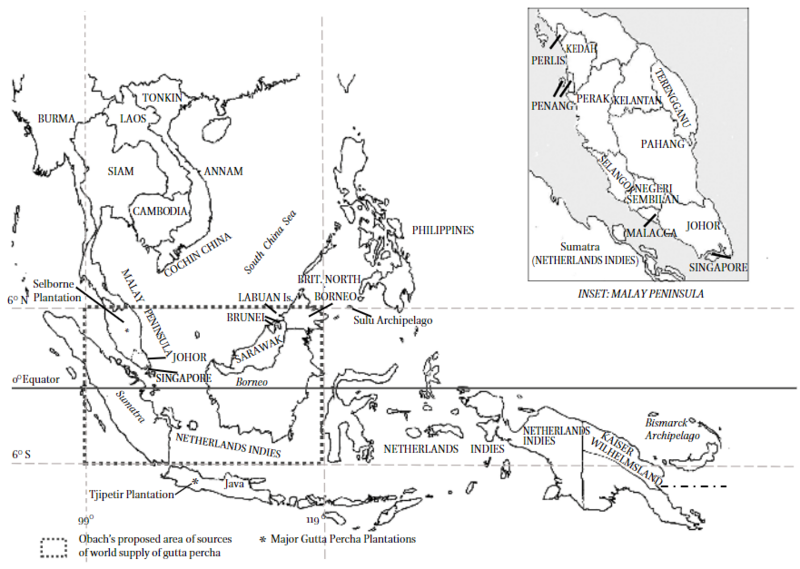
“Map 4: Historic map of sources of world supply of gutta percha in the nineteenth century. Note: Obach’s outline of the region that provided gutta percha for the world’s sub-marine telegraph cables is marked. In fact, British North Borneo and the southern Philippines also supplied gutta percha, although the latter product, justifiably or not, was not well regarded by the telegraphic industry.”
(Sumber: Godfrey, H. (2018): "Chapter 3 The Rise and Challenges of the Gutta Percha Trade". In Submarine Telegraphy and the Hunt for Gutta Percha. Leiden, The Netherlands: Brill.).
1905-08-02: Hujah Pewartaan Hutan Ayer Itam
Pada 8 Februari 1905, Office of Conservator of Forests F.M.S. & S.S., di bawah seliaan pegawai perhutanan Arthur B. (A.B.) Stephens, memohon sebidang tanah di antara Ayer Itam dan Sungei Besi untuk tujuan pewartaan sebagai hutan simpan. Menurut laporan pembantu beliau Mr. Paul, terdapat banyak pokok Taban (Gutta Percha) muda berukur lilit antara 18 inci hingga 3 kaki, juga banyak pokok balak spesis Merbau, Tembusu, Petaling, Meranti dan Jelutong:-
“I have the honour to apply for the piece of land situated in the Ayer Itam and Sungei Besi Mukims of the Ulu-Langat district as marked in the accompanying plan. This has been explored thoroughly by our Assistant Conservator Mr.Paul. He says “I have explored this area throughly and find young trees in large quantities all over it. On some of the hill on the southern portion I saw Taban trees varying from 18 inches to 3 feet in girth. There is also plenty of good timber here, Merbau, Tembusu, Petaling, Meranti and Jelutong being plentiful. … - A.B. Stephens”
(Sumber: PEJABAT SETIAUSAHA KERAJAAN NEGERI SELANGOR, 02/08/1905: |"PORPOSED FOREST RESERVE IN AYER ITAM AND SUNGEI BESI MUKIMS, ULU LANGAT DISTRICT - RE :-").
LATAR PERISTIWA: Hutan Simpan Ayer Itam.
1942-1945: Penanaman di Hutan Simpan Bangi
Ketika pendudukan Jepun di Tanah Melayu sekitar 1942-1945, pokok Gutta Percha telah ditanam oleh pihak Jepun di Hutan Simpan Bangi, setelah pokok asalnya ditebang: “BFR received its status as a forest reserve on 31 December 1906 and was placed under strict jurisdiction Of the Selangor Forestry Department. Nevertheless unauthorized exploitation during the post World War II occurred and it was selectively logged during the Japanese occupation in 1942-1945 (Latiff 1981). It was again logged off for the second time in the late 1960's. The Japanese planted Palaquium gutta after the logging was completed as a source for “gutta perca”.” (Sumber: Kamarudin Mat Salleh @ Pertanika J. Trop. Agric. Sci. (JTAS) Vol. 22 (2) Sep. 1999, m.s. 185-198: |"The Role and Function of Universiti Kebangsaan Malaysia Permanent Forest Reserve in Research and Education").
LATAR PERISTIWA: Hutan Simpan Bangi.
